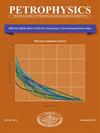Use of Symbolic Regression for Developing Petrophysical Interpretation Models
IF 0.7
4区 工程技术
Q3 ENGINEERING, PETROLEUM
引用次数: 0
Abstract
Complex lithology petrophysical interpretation with multiphysics logging tools has been and continues to be a major challenge in formation evaluation. Many currently used data-driven approaches, such as a neural network (NN), deliver predicted results in numerical quantities rather than analytical equations. It is more challenging if multiphysics logging measurements are collectively used to estimate a petrophysical parameter. To overcome these problems, a physics-guided, artificial intelligence (AI) machine-learning (ML) method for petrophysical interpretation model development is described. The workflow consists of the following five constituents: (1) statistical tools such as correlation heatmaps are employed to select the best candidate input variables for the target petrophysical equations; (2) a genetic programming-based symbolic regression approach is used to fuse multiphysics measurements data for training the petrophysical prediction equations; (3) an optional ensemble modeling procedure is applied for maximally utilizing all available training data by integrating multiple instances of prediction equations objectively, which is especially useful for a small training data set; (4) a means of obtaining conditional branching in prediction equations is enabled in symbolic regression to handle certain formation heterogeneity; and (5) a model discrimination framework is introduced to finalize the model selection based on mathematical complexity, physics complexity, and model performance. The efficacy of the five-constituents petrophysical interpretation development process is demonstrated on a data set collected from six wells with the goal of obtaining formation resistivity factor (F) and permeability (k) equations for heterogeneous carbonate reservoirs. We show quantitatively how individual constituents of the workflow improve the model performance with two error metrics. A comparison of NN-method-predicted permeability values vs. SR-based-workflow-predicted permeability equation is included to showcase many advantages of the latter. Beyond the transparency of an analytical form of the prediction equations, the SR method intrinsically has a more relaxed requirement on the training data size, is less prone to overfitting, yet can deliver superior model performance rival to the NN approach.利用符号回归建立岩石物理解释模型
利用多物理场测井工具进行复杂岩性岩石物理解释一直是并将继续是地层评价的主要挑战。许多目前使用的数据驱动方法,如神经网络(NN),以数值量而不是解析方程提供预测结果。如果综合使用多物理场测井测量来估计岩石物理参数,则更具挑战性。为了克服这些问题,介绍了一种物理指导的人工智能(AI)机器学习(ML)方法,用于开发岩石物理解释模型。该工作流程由以下五个部分组成:(1)利用相关热图等统计工具为目标岩石物理方程选择最佳候选输入变量;(2)采用基于遗传规划的符号回归方法融合多物理场测量数据,训练岩石物理预测方程;(3)采用可选的集成建模程序,通过客观地对预测方程的多个实例进行集成,最大限度地利用所有可用的训练数据,这对小型训练数据集特别有用;(4)在符号回归中实现了预测方程条件分支的获取方法,可以处理一定的地层非均质性;(5)引入模型判别框架,根据模型的数学复杂度、物理复杂度和模型性能完成模型的选择。通过6口井的数据集,验证了五组分岩石物理解释开发过程的有效性,目的是获得非均质碳酸盐岩储层的地层电阻率系数(F)和渗透率(k)方程。我们定量地展示了工作流的各个组成部分是如何使用两个误差度量来改进模型性能的。将神经网络方法预测的渗透率值与基于sr的工作流预测渗透率方程进行比较,以展示后者的许多优点。除了预测方程的分析形式的透明性之外,SR方法本质上对训练数据的大小有更宽松的要求,不太容易过度拟合,但可以提供优于神经网络方法的模型性能。
本文章由计算机程序翻译,如有差异,请以英文原文为准。
求助全文
约1分钟内获得全文
求助全文
来源期刊

Petrophysics
地学-地球化学与地球物理
CiteScore
1.80
自引率
11.10%
发文量
40
审稿时长
>12 weeks
期刊介绍:
Petrophysics contains original contributions on theoretical and applied aspects of formation evaluation, including both open hole and cased hole well logging, core analysis and formation testing.
 求助内容:
求助内容: 应助结果提醒方式:
应助结果提醒方式:


